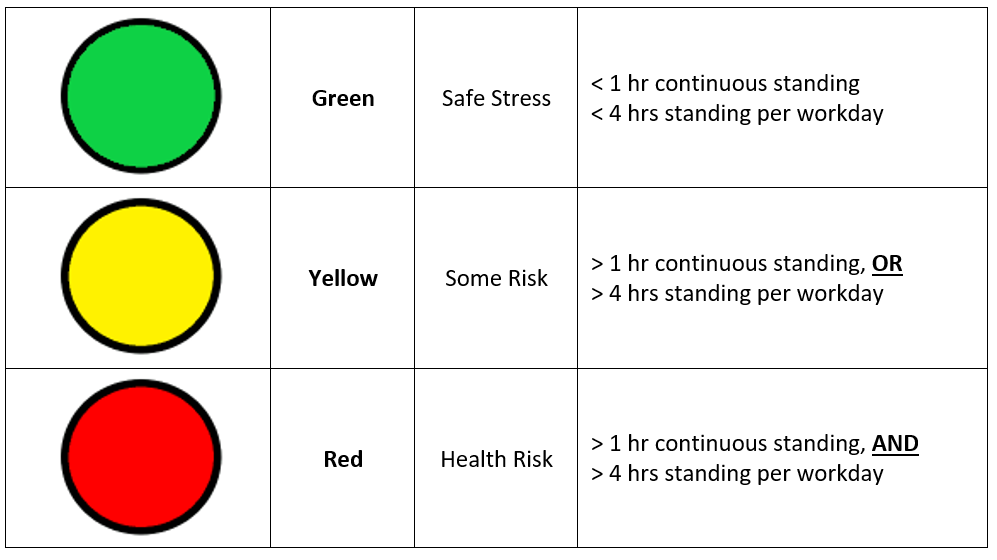Lately, I’ve been spending a lot of time looking into occupational safety guidelines. It turns out there’s a lot to say about the hazards of standing, since standing-related health problems have long been a matter of concern for hairdressers, retail clerks, and health care workers, among others. I’ll chalk that up to “Not News, but News to Me.”
I’ve written about perioperative nurses, and their guidelines on prolonged standing. That led me, in a roundabout way, to an article about OR assistants in the Netherlands.
Dangers of Prolonged Standing
The paper starts by listing some of dangers of prolonged standing, which include:
- Fatigue and muscle pain: Pain happens as a result of continuous tension in the back and legs. Because the intramuscular tension is higher than the surrounding blood pressure, muscles don’t receive an adequate blood supply and will acidify. Over time, this can cause permanent damage, which eventually lowers the threshold for pain and fatigue.
- Knee and hip problems: Standing puts pressure on the cartilage in the knees and hips. Again, this can decrease the blood supply. Prolonged standing can also displace the synovial fluid that cushions joints during movement, which means there is more friction on joints during movement.
Later, the paper cautions that, “It is often incorrectly thought that young people are intrinsically protected against effects of physical stress because they are healthy and strong.” The authors point out that the musculoskeletal problems that result from extended standing can start to accumulate from a young age, and young workers are prone to the same types of damage that older people are.
A Stoplight Model for Standing Risk
As far back as 2003, Dutch hospitals used workplace safety guidelines that included limits on static standing. (For OR personnel, standing really does mean standing still – with room for only one or two small steps.) As far as I can tell, hospitals were never legally required to adhere to these standards, but they were strongly encouraged to do so. Government safety inspectors used these guidelines as the basis for their inspections.
I haven’t been able to find an actual copy of the standards, which is hardly a crisis since they are written in Dutch. (Like a good American, I only speak English.)
But I gather, based on this paper by the same author, that these safety guidelines included a handy risk assessment tool for prolonged standing, based on a green/yellow/red stoplight classification.

Results and Recommendations
I’m sure you’re dying to know how those poor OR assistants in this study from thirteen years ago fared. The results were broken down by workday (not worker) and were as follows:
- Green: 36%
- Yellow: 47%
- Red: 17%
The authors’ first-choice solution can be summed up as: Just stop standing so much. They recommended that workplaces try to keep workers within the green category as much as possible, by encouraging a rotation of duties and allowing workers in the OR to walk around or sit briefly but regularly.
In cases where it is not possible to reduce prolonged standing, the authors advocated for the use of aids like compression stockings, or posture training. But they cautioned against toting such interventions as solutions, noting, “After all, using these aids could even lead a person to increase his or her standing time, even though the stress placed on the muscles is seldom reduced using these measures.”
Their recommendations were in line with the Dutch Working Conditions Act, which states:
[U]nless this cannot reasonably be required, hazards and risks to the safety or health of the employee shall wherever possible be avoided or limited at source in the first instance; to the extent that such hazards and risks cannot be avoided or limited at source, other appropriate measures shall be taken, with measures aimed at collective protection having priority over measures aimed at individual protection; appropriate and properly-fitting personal protective equipment shall be supplied to the employee only if the employer cannot reasonably be required to take measures aimed at individual protection[.] (Article 3, Section 1.b.)
Takeaways for Those With Sitting Disabilities
If you are Dutch, or work in a hospital, you may have some luck applying these guidelines to your own situation. But if not, the parallels are a little less obvious.
Personally, I found the green/yellow/red distinction laughable. When I worked at an office job, I stood for 9 hours a day at work, and then returned home to stand some more. During my worst phases, I was on my feet for 20+ hours a day, and the only real break I got from standing was walking. I can’t imagine any ergonomic specialist would endorse that particular work strategy.
However, this study, and the standing safety guidelines, provides a useful objective assessment tool, and could be a useful data point when discussing workplace accommodations. I see no reason why the particular safety limits for standing would differ by occupation. Whether you are an accountant, barber, cashier, lawyer, or surgical assistant, you have no special immunity to standing-related musculoskeletal conditions. It can be difficult to explain to employers why exactly standing all day poses a problem, but there’s no need to reinvent the wheel when other groups in other countries have already put together best practices.

3 thoughts on “Are You Standing in the Red Zone?”